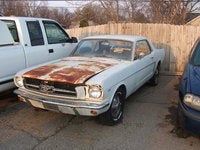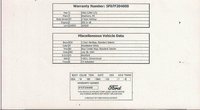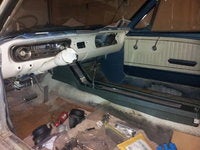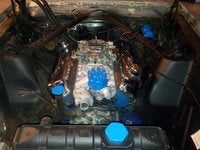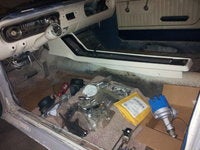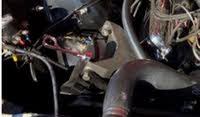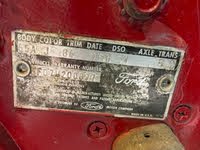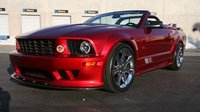rare 64 1/2
Asked by rst429 Sep 07, 2014 at 02:24 AM about the 1964 Ford Mustang Coupe RWD
Question type: General
This is Bob Taylor. I just bought a 64 1/2 mustang with 57000
> miles on it, nice clean car. My son and I are going to restore this fall.
> 260 , C4, Wimbledon white, blue interior. Most people say that there were only 92,705 coupes made. but mine is a original, and the vin# clearly states 204,000 But the Vin# has me
> confused. It has two assembly plant codes on it, can you shed some light on
> this for us? # 5TF07F204000. I know that the [F] is for Dearborn Mi. and
> the [T] is for Metuchen New Jersey, but have you ever seen a car with
> both? Any info would be very appreciated. Thanks from the both of us.
30 Answers
Wow! What a great find! When FordNut wakes up he'll have a better idea then i do. Please what ever you do. Don't "Pimp" it.
1964 1/2 ---- 121,538 we produced, but the VIN will identify it as a 1965, and can you double check the VIN please? Different manufacturers used different VIN systems until they were standardized as 17 alpha-numeric in 1981, but I thought it would have 13 digits
OK there were indeed only 92,705 coupes and 28,883 convertibles for 1964 1/2 but it looks like that VIN is including the 1965 model year. The '64 1/2 is a recognized legitimate model year, but just not for the VIN which includes 1965
http://www.mustangdecoder.com/decoder.html ....I was wrong it does have 12 digits..my bad. Go to that site and click 'instructions' but first, hopefully it's still legible after 50 years, write down everything you can see on the sticker on the doorjamb, or take a picture of the sticker .."warranty" number is VIN
It was your vin number that caught my attention. I have never seen a vin with more than 5 characters prior to the production code for these early Mustangs. I have also ran into some information that Metuchen did not produce any 64½ Mustangs, but I never tried to confirm that. But I do have a friend at the Department of Revenue. I place a call, provided her the vin, and it comes back invalid vin number. So make sure you check the vin very closely. While I was waiting for my friend to return my call, I dug out some really old research I had done on 64½ Mustangs about 15 years ago. My first car was a 65 Fastback and I’ve driven Mustangs ever since, nor to mention restoring, and judging quite a few. Most of the following has came from research that I did with some thought to publishing a book or at least an article. It comes more from the library than the internet. There simply was not as much information on the internet back then as there is now. There is a lot of information out there, but this reflects the “consistent” information (i.e., confirmed by four or more different and unrelated sources) that I accumulated, and it is also consistent with the 64½ that I purchased to restore. Remember it is strictly informational, not well organized, and not checked for grammar, spelling and all that. If I were going to go to all that trouble, you would be paying for some magazine to read this in. So for the nay sayers out there, this is what it is, and consists of what I read, kept, and am sharing, if you wish to argue, go do that with someone else. Verifying a 64 ½ Mustang is about as easy as verifying an actual GT Mustang. You know what they have, so you look at the things they don’t have, and in most cases it is best, educated, guess, with a high degree of probability. Production began March 9, 1964 and ended August 17,1964 (others state July 31, 1964) - Only Coupes and Convertibles were manufactured during this period. - Only Generator equipped cars were produced during this period. - Date codes are OCO through OHO, (found on the VIN Data plate). You can check the date code on your car and compare it to the dates I listed above. But with a production number over 2000000, I seriously doubt it was built before Mid-August 1964. When the Mustang entered production early in March 1964, it didn't have many of the refinements it would have later on; call it a reskinned Falcon with bucket seats. To be a '64½ at all, a Mustang has to be factory-equipped with a generator charging system, a 170ci six (U-code), a 260 2V (F-code), or a 289 4V (D-code) low-compression, large horns mounted down on the frame behind the radiator, a brake light pressure switch on the master cylinder, a center "off" heater fan switch, and a generator charge light, just to name the basics. These are features exclusive to Mustangs built between early March and July 31, 1964 (scheduled build date code only). Engines: Early Mustangs had their own lineup of engines, such as the 260 2V. The 170ci Falcon six with four main bearings was standard. The 164hp 260; 210hp 289 4V, low-compression; and the 271hp 289 Hi-Po, which first appeared in June 1964, were optional. Engine compartment: Oil dipstick is on passenger side and very long Oil filler tube is on front cover of engine, not valve covers Ignition coil is mounted flat on intake manifold Brake switch ( 2 wires) is mounted on the master cylinder Engines have a road draft tube, with/without a PCV valve Some, but not all, ’64½ V-8 engines had cast-iron water pump pulleys. Most had stamped steel pulleys. All 1965 had stamped steel pulleys. Most ’64½ V-8 engines had Autolite distributors with an oil wick. This was a small flip open oil cap on distributor base, located on the bottom right side (as you are looking down at it) A generator charging system came with the ’64½-specific lineup of engines, and used a large voltage regulator with separate terminals. A relay (two wires both female “L” shaped connectors) with male connections is located beneath the voltage regulator activated the system. The upgraded Mustang had an alternator charging system. All ’64½ Mustangs had battery cooling vents (3 louvers - running up and down/top to bottom on the core support, directly in front of the battery tray), due to the generator charging system, which made batteries run hotter. Early Mustangs had big loud horns located inside the engine compartment above the strut rods. The horns for the ’64½, are hidden inside the engine compartment, the are not bolted to the outside of the core support. Use this for quick identification if the hood is closed. New, smaller compact horns mounted on the radiator support made the ’65 Mustang more civilized. These little guys produce a softer sound than the big beasties found on the ’64½. Eaton power steering pumps were a ’64½ item. Some had an integral reservoir, and others had an external reservoir mounted on the inner fender apron. All ’64½ Mustangs had the brake light switch screwed into the master cylinder. This is a pressure switch. Replacement disc brake master cylinders, will have a flat spot cast into the master cylinder. But it is untapped for the brake light switch. Ford moved the brake light switch underneath the dashboard for the ’65. Hood hinges were painted black on ’64½ Mustangs. Hood Bumpers have recessed Phillips screw to hold bumper to stud. Newer bumpers were solid topped. Body: Most ’64½ Mustangs had sharp leading edge on the hood. This is often referred to by Mustang enthusiasts as the “unimproved” hood, or “’64½ hood,” but not all ’64½ Mustangs were fitted with this hood. The Indy Pace Car hardtops, for example, weren’t fitted with this hood, and most promotional vehicles weren’t, either. Examine this sharp edge and you begin to understand that it is a hood lip that hasn’t been crimped (folded under). This was a stamping die issue for Ford’s Dearborn stamping plant. The edges of the Hood have stiffening skirts (flanges) The unimproved hood leading edge created a clearance problem with the headlamp bezel, which is why ’64½ Mustangs had a beveled bezel. The headlight extensions have corresponding bevels to the hood skirts. Even ’64½ Mustangs with the improved hood had beveled bezels. And believe it or not, some borderline units had both—beveled on one side and nonbeveled on the other. The gas cap of a 64½ has no security cable. The word Mustang on the front fenders is 4-3/8". This was later later lengthened to 5.0" Windshield wiper shaft bases are chromed pot metal and have a threaded pivot The taillight harness changed for the ’65 with the deletion of the 3 wire pigtail assembly and the introduction of a water tight socket. The spare tire hold-down of the ’64½ was slotted. The 1965 utilized a “J” hook. Interior: Clip-style door handles were used in production until March 1965. It wasn’t until early March 1965 that screw-on door handles entered production. Color-keyed lock buttons were sporadically used in early production. Ironically, Mustang No. 1, 5F08F100001 is equipped with chrome lock buttons. Like the unimproved hood, there is no solid answers on that one. Carpeting stops at rocker stiffener plate, color-keyed vinyl under door sill plate . The carpet didn’t meet the sill plate during 1964. Carpet ended at the rocker panel, and interior-color vinyl filled in the gap. Carpet had color-keyed rubber heel pad, no toe pad, as in later models. Carpeting for the ’65 became molded and went all the way to the sill plate. Front Seatbelts are secured with an eye bolt Passenger seat was fixed into position with no fore/aft adjustment Most, but not all, ’64½ Mustangs had an “A” in the vent knob. Instrument Cluster has Red "GEN" light (Generator), later 1965 models had Red "ALT" light (alternator) Heater blower is two speed with the "OFF" position located in center Smaller "T" handle on automatic transmission equipped cars And that is about the extent of my knowledge. However, I would caution against any absolutes, such as some of the information says "All" when it would be most advisable to think "most all." Having owned and dealt with Mustangs since 1966, I have learned that no two are identically built and anything is possible. Hope his helps you out some.
Wow! I am blown away with all of that information you have accumulated! It's worthy of any automobile magazine! Thank You.
Indeed very informative, thanks again, I've done a little research on the two plant codes on my 64 1/2 , where can i send some pic's that may clear this mater up??????
I know the vin states 204000, but not all the cars, going down the line where mustangs!,maybe one forth where, so I can't go on the vin # alone, Or am i mistaking??
Js08016 my vin # has two plant codes, will anybody address that problem.. all the other #, a 6 year old can decipher in 10 mins
There are other places that the VIN is located. I don't recall if there is one on the fenders along where the hood and fenders meet. Could be to early but take a look.
http://www.mustangandfords.com/news/mustang-1964/
GWL I went to that web site first remove the T, then remove the F and then used both T&F I have the pic's posted on my 2010 liberty pic page, it clearly states it a 64.5 and notice the build date and year......Thanks Bob T
My 1964.5 does have a Gen,and large horns mounted on the frame between the radiator and shock tower, it also has a build date of July,28,1964
Here's a picture of the build code and door plate, NOW LOOK AT THE ASSEMBLY UNIT #
MY VIN# is 5F07F204000, But it is clearly a 1964.5. My question is to all the CarGurus out there is, How many were really made before AUG,1,1964?????? Mine was built on July, 28,1964.....Look at my above answer,and look closely at the build plant and door plate and build date.......hope this helps
Js08016, Tell your 6 year old thanks,lol,lol But why is my unit # so high,and was built on July,28 of 1964????????I just don't understand!!!!!!!
Thats what i been trying to tell everybody for years, there were not just mustangs, running down the line, falcons,Galaxie,comets, and fairlanes.....Thanks for clearing that up for alot of people here in CarGurus And Js08016, I took off my steering wheel, and found under the mustang round emblem, was a ORG. Falcon Sprint wheel, that had been put on by mistake, on the line, and was caught by a worker, just before it went out the door, for shipping destination, pretty cool right!!!!!
Js08016, Thx, it's a lot of work, but it will look sweet when it's done, Wemblon White exterior, blue/white pony interior, just painted the dash white, and the center console
here's a few pic's on how it's coming....
I'll send the new pic's of the repainted center console later.....
BoholMark,Js08016,FordNut : I'v decided to sell the old mustang, just a little more work then i can do,My son is getting ready to start college, and if you know anybody looking for a good project 64 1/2 please free to call..Thx for all your time and info over the year....
The oil dipstick and shaft do not appear to be the proper 64 1/2 parts. The correct ones were longer than the dipsticks and associated shafts and the shaft has a bend near the top as the dipstick on 64 1/2 came up through the opening in the generator's mounting arm. This is a common 'engine rebuild' problem, especially if you are not rebuilding the original motor that was assembled with the rest of the Mustang. New or rebuilt 1965, 289cid (or 260 cid) engines post August 1964 all had the dipstick shaft running outside the mount.
ScroatBagGarage answered about a year ago
My 64 1/2 is 5F07U200077 (date code 15G). Mfg July 15, 1964 and has every single 64 1/2 tale tale sign ever mentioned. All original driver (87k showing), garaged 35+ years before I got it. Had a repaint of aftermarket red in the 80's (original Rangoon Red still in trunk, underhood, interior behind panels and areas in jams where flaked off). Only complaint is someone swapped the front buckets (65A) for a front bench/armrest (65C) likely in the 70's. A little rough but all original otherwise. Hood springs, hood edge, headlight bezels, big horns on frame, master cyl, red valve cover/cleaner, generator, falcon dash, GEN light, Off in middle, AM radio w/ scale starting at 6 (not like 65 radio that started with 5), square interior door pull, A on vent knob (carpet mostly gone), window cranks w/ clips, gas cap no cable, no reverse lights, jack/tire doesn't have J hook. All sheet metal shows date coding as May/Jun/July (64). Shows cracking 'bondo' around quarter and a couple of areas (thus the repaint I think). Looking to restore as it has got to be easier than a '57 Belair was (and cheaper).
ScroatBagGarage answered about a year ago
65A - Front bucket seats J - Rangoon Red 86 - Black vinyl/trim 15G - 15 July 54 - Omaha 3 - 3.20:1 6 - C4 Auto 1965, Dearborn, hardtop, 170cid 6, 100077 th off the line. (they started with 100,001 and the mustang, falcon, fairlaine all ran down the line together)
